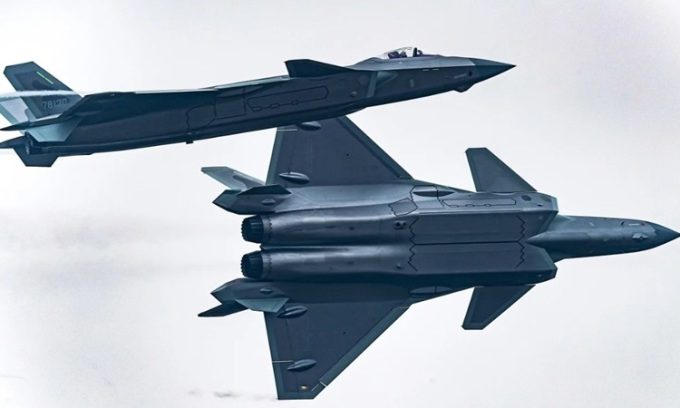A team of scientists and engineers has developed a new generation of plasma stealth technology that can make nearly any military aircraft disappear from radar screens.
Unlike earlier versions that created a plasma cloud enveloping the entire aircraft, the new technology can be adjusted to conceal specific radar-vulnerable areas of military aircraft, such as radar domes, cockpits, or other critical spots. This plasma stealth device, which utilizes a closed electron beam, focuses on protecting important areas rather than the entire aircraft, as reported by Interesting Engineering on February 19. It offers several advantages, including a simple structure, a wide voltage adjustment range, and high plasma density, described by Tan Chang, a scientist involved in the project, in the journal Chinese Radio Science.

Plasma stealth technology can provide significant advantages for fighter jets. (Photo: Weibo).
The technical solution may soon be applied to various types of military aircraft, according to Tan and colleagues at the Plasma Technology Center of the Xi’an Aerospace Propulsion Institute of the China Aerospace Science and Technology Corporation.
Plasma consists of charged particles that interact with electromagnetic waves in unique ways. When electromagnetic waves, such as those emitted by radar, interact with plasma, they cause the particles to move rapidly and collide, dispersing wave energy. This interaction transforms the energy of electromagnetic waves into kinetic and thermal energy of charged particles, thereby reducing the intensity of the electromagnetic waves and weakening the radar signals transmitted back. Even conventional fighter jets not designed for stealth can significantly decrease their radar visibility thanks to plasma stealth technology, providing an advantage in aerial combat.
Plasma can alter the frequency of the reflected signal, causing enemy radar to gather inaccurate data regarding the aircraft’s position and speed. It can also act as an “invisible shield” against high-energy microwave weapons. An increasing number of Chinese military researchers believe this technology will play a crucial role in the future.
Tan’s research team has tested two types of plasma stealth devices. One device covers areas of the aircraft that are easily detected by radar using radioactive isotopes, emitting high-energy rays that ionize the surrounding air. The result is a plasma layer thick and dense enough to cover surfaces and scatter radar signals. The other device employs high voltage to activate and ionize the air outside the aircraft, creating a plasma region. According to the researchers, both methods for achieving stealth capability through low-temperature plasma have undergone flight tests and have been successful.
Current plasma stealth technology has some limitations. When exposed to open environments, it can be challenging to shape plasma accurately, and maintaining a consistently high density is also a challenge. Gaps in the plasma can allow electromagnetic waves to reflect back, revealing the aircraft’s location.
Tan’s team developed a device that uses an electron beam to create a large closed plasma region. Compared to other techniques, such as closed radio frequency plasma devices, their method separates the plasma from the source, providing greater flexibility in design to accommodate various aircraft structures. They argue that plasma generated from an electron beam easily adjusts physical characteristics, has higher energy efficiency, reduces the aircraft’s power demand, and is lighter, making it ideal for practical applications. Ground testing with prototypes has demonstrated the feasibility of the design.




















































